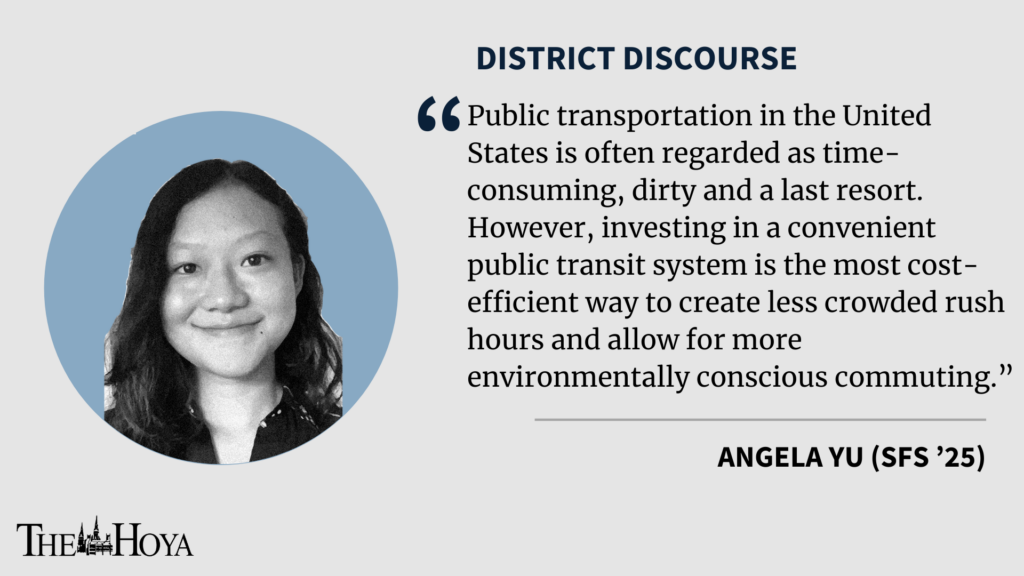One of my first concerns when committing to Georgetown University was whether I could easily travel around the city without a car or the ability to shell out over $30 for each Uber ride.
With the closest Metro station a 30-minute walk away and the Georgetown University Transportation Shuttle buses running only once an hour, exploring the greater Washington, D.C. area requires sacrificing valuable time many students cannot spare. A new Metro station may be unlikely, but improvements to buses coupled with fewer transit delays would make the District a more accessible place for Georgetown students. More broadly, residents of all backgrounds stand to benefit from less congested traffic. To serve the city’s changing demographics, D.C. public transportation must enact substantial measures such as extending bus lanes and optimizing transportation routes.
Debates over providing transportation to Georgetown students have been an ongoing battle between the student body and administration. The Georgetown University Student Association passed a referendum in May supporting the school’s entry into the U-Pass program, which would provide unlimited rides on Metrorail and Metrobus. However, the university’s administration has only promised to examine the proposal and has not approved it for the 2021-22 school year. Even if the program is established, the lack of existing public transportation would still serve as a barrier for students.
The Washington Metropolitan Area Transit Authority has continuously faced budget constraints that threaten to further reduce Georgetown’s transit routes. A 2021 budget proposal in late 2020 eliminated weekend Metro services and reduced bus service by 55%. Notably, the consolidation of Routes G2 and D2 would eliminate a stop in front of the campus gates used by many students and workers. Although advocacy from the university’s students, administrators and workers led WMATA to omit the changes, the event demonstrated the community’s dependence on public transportation.
Numerous surveys have found the majority of D.C. area residents want a solution to the city’s transportation issues. A 2016 Greater Washington Transportation Issues survey reported that 33% of D.C. residents said traffic and transportation was the “greatest long-term challenge facing the region.” Furthermore, 47% believed the most important transportation priority was reducing traffic congestion and delays, while 79% wanted to invest more money into transportation projects. Polls show residents are aware that a primary issue with public transit is congestion due to the lack of infrastructure development.
The East Coast gas shortage in May of this year proved the importance of investing in public transportation. As gas prices soared, many motorists turned to the D.C. Metro system as a reliable alternative method of transportation. Evidence points to an even greater need for public transportation in the future: The Transportation Planning Board in D.C. projected that transit trips will grow 38% by 2045. Many of these new travelers will include students and low-income residents who rely on affordable transportation in their daily lives. Furthermore, population growth in the suburbs of D.C. indicates more commuters will need to travel into the city for work. If public transit is unable to adapt to increasing demand, current issues will only become more prominent.
A 2018 issue brief by the Greater Washington Partnership outlined multiple suggestions to improve the bus system. Among the solutions that most stood out as beneficial to the Georgetown area are expanded bus lanes and optimized routes. Expanded bus lanes have already been introduced on H and I Streets NW, past the White House. The project should be expanded to accommodate a greater number of buses to prevent delays along the line. In addition, population shifts call for a reevaluation of routes and stops. Regions farther from downtown D.C. such as Bethesda, Md., and Rosslyn, Va., have become major economic hotspots. More frequent and direct stops in correspondence with ridership demands would attract new passengers.
Public transportation in the United States is often regarded as time-consuming, dirty and a last resort. However, investing in a convenient public transit system is the most cost-efficient way to create less crowded rush hours and allow for more environmentally conscious commuting. As a demographic that heavily relies on D.C.’s buses and Metro, Georgetown students can be key advocates in this fight. We must reach out to lawmakers in the federal government and local jurisdictions with our personal experiences to help ensure WMATA has an established place in their budgets. For D.C. residents, the city’s buses and Metro are vital resources that cannot be compromised.
Angela Yu is a first-year in the School of Foreign Service. District Discourse appears online every other week.














